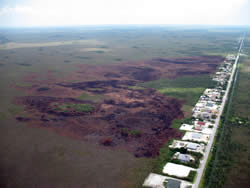
National Fire Plan Success Story
2008 Miccosukee Reserve Area Prescribed Fire
Everglades National Park, Florida
National Fire Plan - Fuels Reduction, Community Assistance
2008

Fire scar from Miccosukee Wildfire which threatened the Miccosukee Reserve Area and Cape Sable Seaside Sparrow habitat. NPS photo, Everglades National Park.

Prescribed fire creates a buffer between Miccosukee Reserve Area and Everglades National Park. NPS photo, Everglades National Park.
On August 5, 2007, a wildfire on the northern boundary of the park threatened both the Miccosukee Reserve Area (MRA) and the federally listed endangered Cape Sable Seaside Sparrow (CSSS) habitat. Everglades National Park fire management personnel took control of suppression actions and along with local resources from Big Cypress National Preserve, the state and county, protected 105 threatened structures while also keeping fire out of the CSSS habitat. The 232-acre Miccosukee Fire occurred during the rainy season with higher fuel moistures. Had this wildfire occurred during the dry season, it would have been much more difficult to bring under control while protecting the special values at risk on both sides of the boundary.
Over 5 months of planning and coordination between Everglades National Park, the Miccosukee Tribe of Indians of Florida, and the Florida Department of Forestry culminated in the successful execution of the Miccosukee Reserve Area (MRA) Prescribed Burn on April 16, 2008. The MRA, designated as a Wildland Urban Interface Community at Risk, is located along the northern boundary of Everglades National Park. South of the burn area is occupied habitat of the CSSS. The goal of this burn was to reduce safely the fuels between the MRA and the CSSS habitat to help protect both areas from wildfires originating on the opposite side.
Personnel and resources from the National Park Service, the Miccosukee Tribe of Indians of Florida, the Seminole Tribe of Florida, and the Florida Department of Forestry completed this fuels treatment. Operations began with hand ignition along the burn area perimeter and were finished by helicopter using a Plastic Sphere Dispenser (PSD) machine. A single engine air tanker (SEAT) was on standby as a contingency resource for the operational period. The burn was performed with north winds to prevent smoke impacts on the MRA and Highway 41, a major travel corridor connecting the east and west coasts of southern Florida. There was little smoke impact on visitors at the Shark Valley Visitor Center. Keeping fire out of cultural and archeological sites was another factor that was mitigated when developing the boundaries of the burn unit. The buffer created by the prescribed burn, anchored into the fire scar from the Miccosukee Fire, provides protection to both sides.
Contact: Rick Anderson, Fire Management Officer, (305) 242-7853.